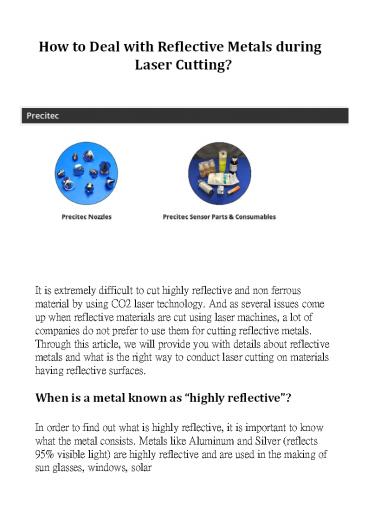How to Deal with Reflective Metals during Laser Cutting? - PowerPoint PPT Presentation
Title:
How to Deal with Reflective Metals during Laser Cutting?
Description:
It is very difficult to cut highly reflective and non ferrous material by using CO2 laser technology. Through this article, we will provide you with details about reflective metals and what is the right way to conduct laser cutting on materials having reflective surfaces. For more information visit: – PowerPoint PPT presentation
Number of Views:27
Title: How to Deal with Reflective Metals during Laser Cutting?
1
How to Deal with Reflective Metals during Laser
Cutting?
It is extremely difficult to cut highly
reflective and non ferrous material by using CO2
laser technology. And as several issues come up
when reflective materials are cut using laser
machines, a lot of companies do not prefer to use
them for cutting reflective metals. Through this
article, we will provide you with details about
reflective metals and what is the right way to
conduct laser cutting on materials having
reflective surfaces. When is a metal known as
highly reflective? In order to find out what
is highly reflective, it is important to know
what the metal consists. Metals like Aluminum and
Silver (reflects 95 visible light) are highly
reflective and are used in the making of sun
glasses, windows, solar
2
mirrors and jewelry. Reflective metals like gold,
bronze, copper and brass are also hard to laser
cut using CO2 lasers. Stainless Steel is also
considered to be a reflective metal especially
when an object made of steel is given a mirror
polish. As the mirror finish makes it difficult
to cut steel, it is coated with plastic on the
cutting side to lessen the risk. Why is it
difficult to laser cut reflective materials? As
CO2 laser cutting technology makes use of light
beams and mirrors for cutting, it becomes
difficult to cut reflective metals. If you cut a
material like aluminum using a laser machine, the
laser beam gets reflected from the metal sheet
back to the laser lens causing damage to the
laser spare parts. If one is using branded
machines like Precitec laser cutting machine, it
can incur a damage of thousands of dollars as the
laser delivery system might have to undergo a
prolonged repairing process and maintenance
including replacement of precitec laser spare
parts.
3
Even if you cover the sheet with a non-reflective
coating, it doesnt always work as the surface of
the metal is not the only source that reflects
light. During laser cutting, heat is generated
and a molten metal is released from the laser
which reflects and causes damage to the beam.
This is the reason why several laser companies
suggest an alternate method like Waterjet cutting
to cut reflective metals. However, Waterjet
method shouldnt be considered as an only option
for cutting reflective metals. So how do you cut
reflective metals? Despite the risk of reflected
beam damaging the laser machines, it is possible
to laser cut these materials. But for that you
need to take certain measures and follow some
parameters. Usually, the modern laser machines
come with a failsafe so that there is no damage
to the equipment. Detectors of the laser head can
identify the radiation levels and shut themselves
off if a lot of radiation is reflected into the
lens. So if the laser and the reflective sheet
are set up properly and the job is done slowly
and smoothly, it is possible to cut reflective
metals. Fiber laser technology Fiber lasers are
the most modern, swift and cost effective way to
cut thin reflective metal sheets. As these lasers
do not use mirrors and delicate lenses, the
reflection from metals like copper, aluminum and
brass do not damage the cutting equipment making
it quick and safe to set up. So Fiber laser
technology is the best way to cut reflective
metals.
4
What Makes Waterjet Cutting a better option? The
only drawback of Fiber Laser Technology is that
it can be used effectively only on the sheets
that are upto 5mm thick. If the thickness of
sheet is more than that, it affects the cutting
speed and shape of the cut. This is when Waterjet
cutting can come of help. Waterjet cutting cut
materials with thicknesses of up to 230mm which
makes it even better than the widely accepted CO2
laser cutting technology. Now that you know how
to deal with reflective metals, you can take up
this task with ease. All the best! Steve M
Glassner is the General manager of Alternative
Parts Inc, the leading manufacturer and
distributor of various CNC machine parts
including Precitec laser spare parts. Steve is a
Machine Tools industry enthusiast and frequently
writes about various aspects of the industry.































